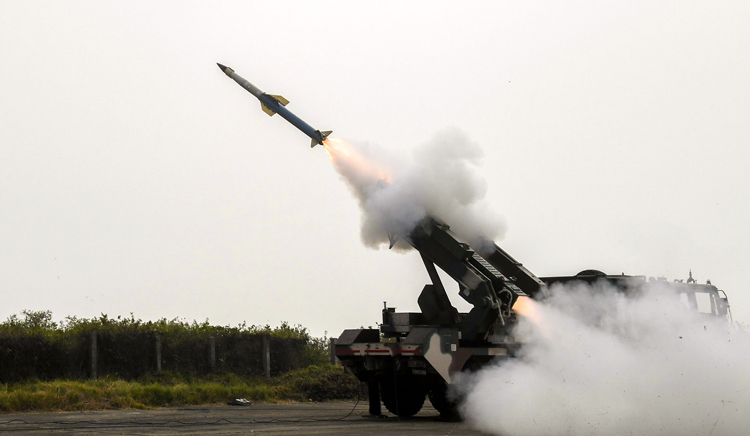INDIAN ARMED FORCES CHIEFS ON OUR RELENTLESS AND FOCUSED PUBLISHING EFFORTS

The insightful articles, inspiring narrations and analytical perspectives presented by the Editorial Team, establish an alluring connect with the reader. My compliments and best wishes to SP Guide Publications.

"Over the past 60 years, the growth of SP Guide Publications has mirrored the rising stature of Indian Navy. Its well-researched and informative magazines on Defence and Aerospace sector have served to shape an educated opinion of our military personnel, policy makers and the public alike. I wish SP's Publication team continued success, fair winds and following seas in all future endeavour!"

Since, its inception in 1964, SP Guide Publications has consistently demonstrated commitment to high-quality journalism in the aerospace and defence sectors, earning a well-deserved reputation as Asia's largest media house in this domain. I wish SP Guide Publications continued success in its pursuit of excellence.
- MoD initiates comprehensive review of Defence Acquisition Procedure 2020, pushes for defence reforms
- G7: The Swansong
- Kalinga Connect: South Asia to Polynesia
- Must Credit DRDO for Operation Sindoor, now what is next for defence R&D?
- The layered Air Defence systems that worked superbly, the key element of Operation Sindoor
- Operation Sindoor | Day 2 DGMOs Briefing
- Operation Sindoor: Resolute yet Restrained
Indigenous QRSAM
 |
The Author is Former Director General of Information Systems and A Special Forces Veteran, Indian Army |

The indigenous Quick Reaction Surface to Air Missile System (QRSAM) developed by the DRDO was successfully flight tested on December 23, 2019 from the Integrated Test Range in Odisha's Chandipur. The missile was tested with full configuration in deployment mode intercepting the target in mid-air and meeting mission objectives. The entire event was monitored by Ground Telemetry Systems, Range Radar Systems, Electro Optical Tracking System, etc. The QRSAM weapon system, which operates on the move, comprises of fully automated Command and Control System, Active Array Battery Surveillance Radar, Active Array Battery Multifunction Radar and Launcher. Both radars are four-walled having 360-degree coverage with search on move and track on move capability. The system is compact with minimum number of vehicles for a firing unit. Single stage solid propelled missile has midcourse inertial navigation system with two-way data link and terminal active seeker developed indigenously by DRDO.
The missile successfully engaged the aerial target establishing its capability. With this mission, the developmental trials of the weapon system are successfully completed and the weapon system is expected to be ready for induction by 2021. It is an all-weather, all-terrain SAM equipped with electronic counter measures against jamming by aircraft radars. The missile can be mounted on a truck and is stored in a canister. The solid-fuel-propellant has a range of 25-30 km. It has the capability to search and track targets while moving. The Indian Army had been looking for replacement of the Russian OSA-AK and Kvadrat missile systems past decades. ‘Akash’ was one of the five core missile systems of the integrated guided missile development program launched by DRDO in 1984; Akash was to replace the Russian Kvadrat System with the Army for providing air defence cover for mechanised forces during manoeuvre battle. Some 23 years later, when the trials were done in 2007 the Army found that while on the move, Akash could not negotiate undulating ground appropriately and had difficulty in acquiring even slow moving helicopters, leave aside fast moving aircraft. The Army therefore rejected Akash outright because it did not meet the requirement of providing air defence for mechanised forces during manoeuvre battle. So Akash was 'given' to the IAF. The IAF did not mind because IAF deploys air defence weapons for protection of vulnerable points and vulnerable areas in layers. So, Akash became one of the air defence weapon in this multi-layered air defence.
Since 2015, Army too was equipped with Akash Weapon System but it still had to be deployed in static role. In recent months the poor serviceability of Akash Missile Systems with the IAF has come under severe criticism, which has also been covered in these columns. Faced with the urgency to provision the military with requisite air defence, a DRDO project to develop quick-reaction surface-to-air missiles was sanctioned in July 2014 with a budget of 476.43 crore. The missile was developed by DRDO in association with Bharat Electronics Limited (BEL) and Bharat Dynamics Limited (BDL) with both firms participating in development and manufacturing – same as for development of the Akash Missile System. The first test firing of the QRSM missile took place on June 4, 2017. This was followed by the second successful test on July 3, 2017, also conducted from Chandipur, Odisha.
Around 100 scientists are working as part of the missile development program led by DRDO’s Defence Research and Development Laboratory (DRDL). DRDO’s other labs including RCI, R&D Engineers and ITR are also contributing to the missile development effort. The third test of the QRSM was conducted on December 22, 2017. Initially this was reported successful but media reports emerged that the missile became unresponsive after taking off resulting in failure of the mission. The fourth test of the QRSAM was conducted on October 8, 2018 which reportedly was successful. The fifth test conducted on February 26, 2019 was also successful. The sixth test was successfully conducted on August 4, 2019 at 1105 am from a mobile truck-based launcher at the launch complex-3 of the Integrated Test Range (ITR) at Chandipur. The test conducted on December 23, 2019 was the seventh test of the QRSAM, successful completion of which development phase of the missile system has been completed. Presumably the Division of Military Affairs be established under the CDS in the MoD will have enough clout over the Department of Defence Production (DoPD) to ensure that serviceability of the QRSAM after being fielded into the military does not suffer the same fate including on account of poor quality spares, as is currently happening with the Akash Missile Systems.





